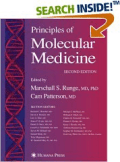|

|
Marschall S. Runge, Cam Patterson
Principles of Molecular Medicine
This fully updated and expanded edition of the much-acclaimed Principles of Molecular Medicine provides an integrated survey of the basic principles of internal medicine, in light of recent dramatic discoveries in molecular medicine and new technologies for the diagnosis and treatment of human disease. In addition to fully revised sections on neurology, cardiology, hematology, nephrology, endocrinology, dermatology, immunology, gastroenterology, pulmonary disease, musculoskeletal medicine, and psychiatry, this volume contains new sections on genetics, oncology, metabolic diseases, and infectious diseases. These sections include the latest findings about direct links between genetic mutations and diseases, genomic approaches to a variety of diseases, and stem cell populations that regenerate muscle, heart, and neural cell populations. Other advances elucidated include the roles of bone morphogenetic proteins in pulmonary hypertension, mutations involved in an array of cardiomyopathies, and a new understanding of the biology of previously untreatable neurodegenerative diseases, such as Huntington's disease.
Humana Press; 2006
|



